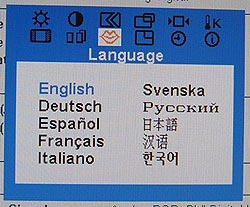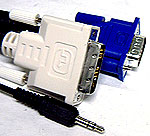|

|
"Magic Bright" lets you increase the brightness
of the screen all the way up to 400 nits - substantial considering
most LCD monitors are capped off at 280 nit brightness ratings.
80% Rating: 
|
|
|
|
Home >
Reviews >
Monitors >
Samsung 172w |
|
|
172W OSD and Display Evaluation Notes
Samsung
have maintained a very concise OSD menu system for the last few years and
the 172W is no exception. Navigation with the control keys on the
front bezel is also not very complicated as the layout is pretty standard
stuff.

The OSD does some neat (and pretty pointless) things like being able to
halftone, or move to different areas of the screen. Realistically speaking, I
don't believe there are many people out there who really need "features" like
these, but I suppose someone ultimately will write in saying they do.
The on screen menus appear as follows and allow the user to adjust these
display parameters: Brightness; Contrast; Image Lock: Coarse, Fine; Position:
H/V; Color Control: Red, Green, Blue; Color Reset: Geometry, Color; Image Size:
Normal, Expand 1 &2; Image Effect: Scaling on/off, Filtering; Language:
English, German, Spanish, French, Italian, Swedish; OSD Position: H/V; OSD
Display Time: 5, 10, 20, 200 seconds; and Display Mode: Hl/V Frequency &
Resolution.
Magic bright is in a separate menu and consists of four settings: User,
Internet, Text and Entertainment. The user and entertainment settings are
brightest making it ideal for watching a movie for example.
As with all
LCD capable of analog-input, the best way to configure that method of connection
to the computer is to toggle the Auto adjust key and just sit back. The engineers at Samsung
must have been tinkering with that function since it moves at twice the speed and
only takes but a second with this display.
| PCstats TFT Display Evaluation
Criteria: |
|
We evaluate the quality of TFT displays with
the help of a program called Nokia Monitor Test. The software application
displays a range of colours and test patterns that can help diagnose just
about any visual problems or defects a TFT display may contain.
It can also be a very useful tool for
properly adjusting a display to the optimal settings. The software
consists of eleven tests which can be run in steps as adjustments are made
to the OSD. As the tests are run we look for the following problems, only
one of which should be inoperable (broken pixel).
Broken Pixels: What we class as a 'broken pixel' can
fall under any one of the following circumstances: Pixel always on (any
colour), pixel always off, pixel unable to display a shade (red, green,
blue, black, white), pixel shown colour gradient.
Pixel Clock: If the number of dot clocks within one
horizontal synch are not properly configured the screen will appear to
drift or vertical stripes may be generated. This should be correctable by
the on screen menu.
Phase: If the phase of the display data and dot clock
are not correctly tuned the screen can flicker, or text be displayed
blurry. For example text may appear dithered, or when looking at a test
pattern of a one-pixel black, one-pixel white checkerboard pattern the
pattern may be distorted. This should be correctable by the on screen
menu.
Response Time: We look for any streaking associated
with moving a full page of text up or down quickly. Displays with slower
refresh rates tend to show some degree of image streaking or text
discoloration which can be distracting.
Stand Stability: TFT displays are fragile components and the
stand should offer adequately stable support as well as be easily
adjustable.
We deduct marks for quality control if there are any predominant
broken pixels in a display. While many manufacturers may consider a
few broken pixels acceptable, we believe the high cost of TFT displays
should translate into a clear and unblemished image. |
|
| Display Test System
Configuration: |
|---|
 |
Video Card: |
ATI Radeon 8500 |
| Operating System: |
MS Windows 2000 |
| Display Settings: |
Color Temp: 6500 Kelvin
Resolution: 1280x768
pixels
Frequency: 60Hz, digital
Colour: 32
Bit |
|
|
| LCD Display Test |
Test Notes and Observations |
|
| Geometry: |
LCD's inherent
design
means that test grids are displayed very true and very
sharp at their native resolutions. The Samsung 172W does well under normal viewing with
the 1280x768 resolution, but under the grid tests the boxes are not
perfectly square. Since the test pattern is not scaled to fit the
resolution, and the screen itself is rectangular this is to be expected.
|
| Brightness and Contrast: |
Very nice shading
under the gray scale test. The percentage white scale bars were
clear and desaturated which was good to see. Using the digital
signal often has benefits with LCD displays since there is very little
adjustment required. It is
important to ensure that the screen is set to 32bit or transitioning shades can
see rather blocky.
|
| Colour: |
The white, red,
green and blue test screens were bright and consistent over the entire screen area
(ie, no dull areas at the edges of the screen). There were no
visible dull or broken pixels which is a good indication that Samsung QC
is doing its job.
|
| Convergence: |
The grid test
patterns in RGB illustrate the worst case situations when different
coloured pixels must work closely together, and since they comprise different
parts of a pixel they do not line up exactly
on LCD screens where there is less blending. Since the pixels on the
172W are 0.289mm in size, the effect is a little more noticeable
than a standard 17" display which uses a 0.264mm pixel dot pitch.
|
| Focus: |
This test has a
few patterns of alternating
black and white boxes with text in them. In the center of the
page are two boxes with 1 pixel vertical stripes. All test patterns showed up
perfectly - if you try this test on your monitor pay close
attention to the center two gray boxes, where interference can sometimes
be visible.
|
| Resolution: |
Resolution was
excellent at the native 1280x768 size. Image dithering at a non-native
800x600 resolution was pretty decent from a distance, and should indicate
that if you are watching a movie that defaults to this lower resolution,
the picture
will be smooth, and text legible.
|
| Moire: |
Since we tested
with the digital signal there were no problems at all
with any of the test patterns. Under analog we did see some
very faint moire lines on the one-pixel square test
pattern.
|
|
Other Evaluation Notes: |
Overall the
Samsung 172W handled the Nokia
Monitor Tests very well - the only major issue
worth mentioning is that even though this is technically a 17" LCD, the pixel
dot pitch is set at a larger degree which is typically found with
15" monitors. For everyday work this isn't an issue for concern, but for high
definition CAD work, a standard 17" screen would be preferable.
|
|
|
|
|
|
|
|
